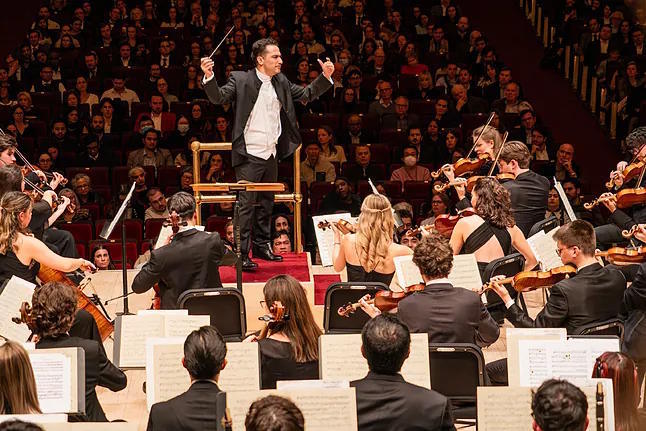In the late 19th and early 20th centuries, a generation overflowing with thinkers, artists, and scientists shaped a completely new vision of the world. "Wild and strange, brutally mechanical, dark and incomprehensible," in the words of historian Philipp Blom. A phenomenon of rupture and avant-gardes throughout the West, but with marked differences on both sides of the Atlantic. In 1893, in New York, Antonin Dvoák presented his Ninth Symphony, the New World Symphony, with resounding success. Dvoák, leaving behind a tradition laden with recognition, the weight of a continent, and a dominant culture that was losing rigidity, opened up to an American musical language, influenced by the songs of Native Americans and African American spirituals. A work of hope, curiosity, and transformation. In 1913, two decades, but actually an eternity later, Igor Stravinsky shocked Paris by translating "the bloody spasms of the revolution" at the Théâtre des Champs-Élysées in The Rite of Spring, a cruel ritual sacrifice in the form of a ballet depicting a youth seeking new ways to express unbridled and uncontrollable rage.
These were fast times, too fast, leading to World War I. Full of uncertainties, technological changes, and emerging scientific paradigms. A time of revolution, nationalism, anguish, distress, and also immense talents. A time of vertigo, exactly like now.
On Thursday night, the Reina Sofía School of Music Orchestra, under the direction of maestro Andrés Orozco-Estrada and with French violinist Renaud Capuçon as the featured soloist, made its debut at Carnegie Hall in New York, building a bridge of strings between these two Atlantic shores and two worldviews. With a stimulating yet fluid approach to modernity and its tonal protagonists. A literal commitment to cosmopolitanism (both among the members and in the repertoire) that blurs labels with a program, not coincidentally titled Journey to the New World. Honoring a Spaniard, an American, and a Central European who roots both traditions.
Under the watchful eye of Queen Sofía, who this year is focused on activities to highlight the importance of the Hispanic legacy in the history of a republic that will celebrate its 250th anniversary in 2026, and of the founder, Paloma O'Shea, seventy students from the school and 15 musicians from the Young Philharmonic of Colombia brought a message of optimism and reconciliation in a historical moment marked by aggression, profound changes like AI, and challenges in distinguishing truth from lies.
A musical discourse of fusion, of languages, styles, and traditions beyond the scores, playing with memory, nostalgia, and at times something darker. The evening began with the freshness, joy of Iberia by the European and polyglot Isaac Albéniz and the sober traditionalism of Barber's Violin Concerto, the last of the romantics. Ending with the Symphony No. 9 in its four movements by the Czech genius.
A journey, a century later, starting in one Port, that of Santa María, and ending in another, that of New York, associated by excellence with immigration and the melting pot of cultures. A classical concert, blending the corsets of classicism, concluding with a zarzuela, the interlude from The Wedding of Luis Alonso by Gerónimo Giménez, with tambourine and castanets, to the delight of an enthusiastic (homeland) audience, rising to their feet for five minutes of intense applause in a nearly full Stern Auditorium.
Albéniz and Dvoák made efforts to integrate local or national folklore into classical music, giving Spain and the US their own personalities. Just as the Reina Sofía school aims to shape a musical identity for its students, surprisingly comfortable in an environment so rich in history and intimidating.
The performance started off steadily, contained and without flourishes in the initial moments, becoming expectant when someone of Capuçon's caliber, who recently performed in front of all of France alongside his brother Gauthierat the reopening of Notre-Dame Cathedral, took center stage for Barber's solo. But gaining more strength, personality, and passion in the final part, absorbing the always contagious energy of Orozco-Estrada, to the rhythm of the horns and English horn of the young Manuela Candela that give meaning to the Largo of the symphony.
"I came with curiosity but without many expectations, and I was surprised," remarked Anne Sophie, a New Yorker and regular at Carnegie Hall. "Magnificent, they have immense talent, and I see a bright future for them if they continue working," agreed a Spanish couple originally from Spain but residing in the Big Apple for over 40 years.
The school mobilized nearly 200 people including students, teachers, technicians, and monitors. An immense logistical and economic effort that was rewarded by the New York audience, with a strong presence of the Spanish community residing here.
An experience in Manhattan for the students that, in addition to the concert, includes social and educational activities to "build bridges," as explained by their organizers, with some of the most important American musical institutions, such as the New York Philharmonic, the Juilliard School, the Ensemble Connect of Carnegie Hall, the Queen Sofía Institute, and the Harmony Program.
The concert was supported by an Honorary Committee with H E. Sheikha Hind bint Hamad Al Thani, Vice Chairperson of the Qatar Foundation; Ana Botín, from Banco Santander and member of the Board of the Reina Sofía School of Music; Aline Foriel-Destezet, member of the International Circle of the Reina Sofía School of Music; Beatrice Santo Domingo, member of the Board of Carnegie Hall; and H E. Huda I. Alkhamis-Kanoo, founder of the Abu Dhabi Festival
